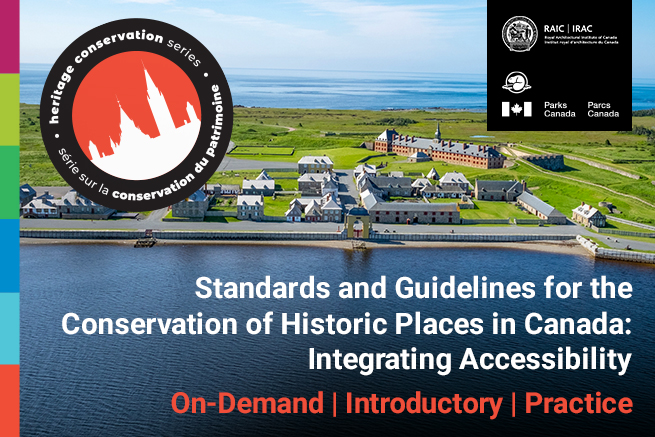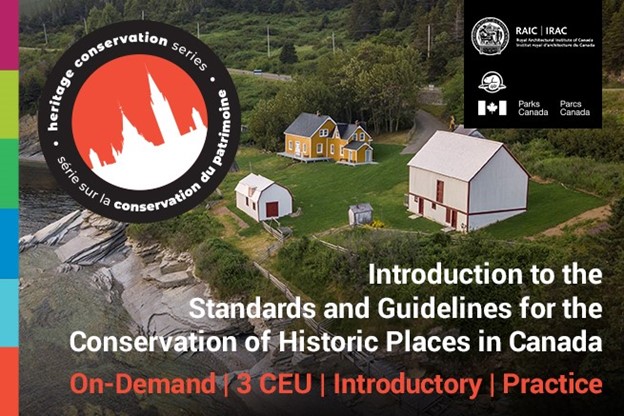About the RAIC and Parks Canada Partnership
The Royal Architectural Institute of Canada has partnered with Parks Canada to offer a series of e-modules. These modules will explore topics related to the Standards and Guidelines for the Conservation of Historic Places in Canada, emerging technologies and digital tools, and adaptive reuse design strategies. Participants will gain exclusive access to nationally significant sites, world-class resources, and leading experts in these fields. These workshops are intended as an informational training tool for interested parties from Canada's heritage community and the design and construction industry.
CLICK HERE FOR INFORMATION IN FRENCH
Standards and Guidelines for the Conservation of Historic Places in Canada: Integrating Accessibility

On-demand I 3CEU I Introductory I Practice
The Royal Architectural Institute of Canada (RAIC) has partnered with with Parks Canada to offer the second module in a series of online learning. This e-module focuses on incorporating accessibility into heritage conservation projects across Canada and provides a comprehensive explanation of how to apply the Standards and Guidelines for the Conservation of Historic Places in Canada (2010) to accessibility projects in historic places. This e-module will soon be available. You can pre-register today to receive a notification upon its release
Learning Objectives
At the conclusion of this course, participants will be able to:
- Explain the key concepts when considering an accessibility project at a historic place;
- Identify which conservation treatment, Standards and Guidelines support accessibility interventions at a historic place;
- Recognize how the early integration of heritage conservation professionals in the conservation decision-making process supports the discovery of options to meet functional requirements as well as mitigate loss of heritage value; and,
- Describe the conservation decision-making process, in applying the Standards and Guidelines in an accessibility project through a case study of a historic place.
If you don't have an account with the RAIC or our learning management system (LMS), one will automatically be created for you during the registration process.
Introduction to the Standards and Guidelines for the Conservation of Historic Places in Canada

On-demand I 3CEU I Introductory I Practice
The Royal Architectural Institute of Canada (RAIC), in partnership with Parks Canada Agency, offers an introductory e-module on the Standards and Guidelines for the Conservation of Historic Places in Canada (2010). This module will cover topics related to heritage values, character-defining elements, and conservation treatments such as preservation, restoration, and rehabilitation.
Learning Objectives
At the conclusion of this course, participants will be able to:
- Recognize heritage values and the character-defining elements of historic places.
- Explain the Conservation Decision Making Process.
- Locate relevant resources for information on heritage value and designations.
- Distinguish between the conservation treatments of preservation, restoration, rehabilitation.
- Interpret which Standards and Guidelines apply to a given conservation project.
About RAIC x Parks Canada
In 2003, Parks Canada led the development of the Standards and Guidelines for the Conservation of Historic Places in Canada, a federal-provincial-territorial initiative intended to create what was supposed to be the nation’s first-ever pan-Canadian reference document on best practices in heritage conservation.
After its original issue, the Standards and Guidelines were adopted by many federal, provincial, territorial, and municipal jurisdictions as' best-in-class’ guidance for managing Canadian conservation projects and sites. Since then, there has been a sustained and increasing interest in the document.
In 2010, Parks Canada led a federal-provincial-territorial collaboration to update the Standards and Guidelines, resulting in Edition 2.
In 2017, the RAIC surveyed its membership, seeking to understand the areas of professional architectural practice for which members wanted more educational tools and training opportunities. Further training opportunities in heritage conservation and adaptive reuse were among the most requested topics.
At that point, the RAIC contacted Parks Canada, and discussions started about a collaboration to expand awareness, understanding, and use of the Standards and Guidelines.
About Parks Canada
Parks Canada’s mandate is to protect and present nationally significant examples of Canada’s natural and cultural heritage– and to foster public understanding, appreciation, and enjoyment in ways that ensure their ecological and commemorative integrity for present and future generations.
In collaboration with provincial and territorial governments, Parks Canada developed the Standards and Guidelines for the Conservation of Historic Places in Canada, as the benchmark guide for the conservation of historic resources. Parks Canada is pleased to work with the Royal Architectural Institute of Canada to expand awareness of the Standards and Guidelines for the Conservation of Historic Places in Canada, in order to help promote good conservation practice in Canada.



